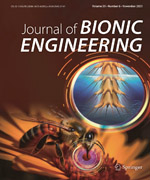|
|
Influence of SiC Nanoparticles Reinforcement in Areca/Tamarind Hybrid Biopolymer Composites: Thermo-mechanical, Tribological and Morphological Features
Gajendiran Hariharan, Pattipati Chinna Krishnamachary, Joseph Selvi Binoj & Bright Brailson Mansingh
Journal of Bionic Engineering
2023, 20 (4):
1723-1736.
DOI: 10.1007/s42235-023-00341-1
Natural fibers are displacing synthetic fibers as reinforcement in polymer composites due to their ease of processing, low cost, wide availability, biodegradability and sustainability. In this study, industrially discarded agro-waste areca fruit husk and tamarind fruit fibers were processed and used as reinforcement with unsaturated polyester resin to create a hybrid composite containing SiC nano filler particles. The SiC nano filler particles were varied from 1 to 4 wt.% in incremental steps of 1 wt.% with a constant 40 wt.% fiber reinforcement to determine its impact on the thermo-mechanical, morphological, wear and hygro-aging properties of the developed hybrid composite. However, the composite made of 3 wt.% SiC nano filler particles exposed overall better properties with better tensile (9.137 MPa), flexural (104.056 MPa), impact (7.983 J/cm2), hardness (91.577 HRRW), wear (2.2?×?10–6 μm), crystallite size (7.9 nm) and thermal stability (360 °C). Further advancement in weight percent of filler material, has worsened the properties due to poor dispersion and agglomeration factors by reducing the tensile, flexural, impact and hardness characteristics by 4.6%, 6.4%, 4.5% and 2.18% respectively. Also, the microstructural investigation revealed the failure pattern, information on interfacial adhesion between the reinforcement, filler and matrix of the hybrid composites. In addition, the crystalline characteristics and availability of functional groups in hybrid polymer composite with 3 wt.% SiC nano filler particles were disclosed by X-ray diffraction (XRD) and Fourier Transform Infrared (FTIR) spectrum analysis, respectively. The above findings reflects that the produced hybrid polymer composites suits well for interiors of automobiles and maritime interior applications to support loads with in the specified range.
Related Articles |
Metrics
|
|



